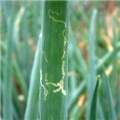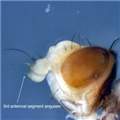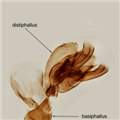Nomenclature
Liriomyza chinensis (Kato 1949)
Dizygomyza cepae ssp. chinensis Kato 1949Liriomyza chinensis (Kato 1949) comb. and stat. nov. Spencer (1973)
Common name: stone leek leafminer
Hosts
Allium spp.
Distribution
Asia: China, Indonesia, Japan, Republic of Korea, Malaysia, Singapore, Taiwan, Thailand, VietnamEurope: France
Key characters
Head largely yellow, mesonotum greyish-black, scutellum entirely dark, femora yellow. Wing length 1.3-2.0 mm. Third antennal segment distinctly angulate, with distinct point at upper corner. Aedeagus with distiphallus enlarged. Detailed descriptions of external morphology, host plants and both male and female terminalia were given by Shiao et al. (1991) and Shiao (2004).
Notes
Spencer (1973) re-examined Liriomyza cepae and split the species into three. Liriomyza cepae s. str. is the "Oggersheim strain" of Nietzke (1943, 1953) and is less widespread in Europe and occurs later in the season than L. nietzkei Spencer which is the "Herxheim race" of Nietzke (1943, 1953). Spencer (1973) also raised the east Asian chinensis ssp. to species level. Spencer (1973) considered that these Allium -feeding species most probaby arose in east Asia. All three species have a characteristic angulate third antennal segment and dark thorax. Spencer (1973, 1989) lists some differences in external morphology: L. cepae and L. chinensis both have a black scutellum but L. nietzkei has a partially yellow scutellum; L. cepae has largely dark coxae and femora, whereas L. chinensis has bright yellow coxae and femora. However, these species are more reliably distinguished by examination of male genitalia (Dempewolf 2004). In recent years, L. chinensis has become an important pest of Allium spp. in SE Asia (Tran et al. 2007) including Vietnam (Andersen et al. 2002) and Indonesia (Rauf et al. 2000). Although restricted to Allium spp., there is anecdotal evidence in Indonesia that the puparia can lodge in the skins of the onion bulbs and so could be transported between regions relatively easily (Aunu Rauf personal communication).
References
Andersen A, Nordhus E, Thang VT, An TTT, Hung HQ & Hofsvang T (2002). Polyphagous Liriomyza species (Diptera: Agromyzidae) in vegetables in Vietnam. Tropical Agriculture (Trinidad) 79: 241-246.
Dempewolf M (2004). Arthropods of Economic Importance - Agromyzidae of the World (CD-ROM). ETI. University of Amsterdam, Amsterdam. https://agromyzidae.linnaeus.naturalis.nl/linnaeus_ng/app/views/species/nsr_taxon.php?id=57041&epi=55
Kato S (1949). A preliminary report on a survey of agricultural pests in Chahar, Suiyuan and northern Shansi. Peking Natural History Bulletin 18: 11-36.
Nietzke G (1943). Rassendifferenzierung bei Dizygomyza cepae Her. (Vorl�ufige Mitteilung.). Archiv f�r Hydrobiologie 1943/44: 48-56.
Nietzke G (1953). Beitr�ge zur Biologie und Epidemiologie der Zwiebelminierfliege Dizygomyza cepae Her. Zeitschrift f�r angewandte Entomologie 35: 249-270.
Rauf A, Shepard BM & Johnson MW (2000). Leafminers in vegetables, ornamental plants and weeds in Indonesia: surveys of host crops, species composition and parasitoids. International Journal of Pest Management 46: 257-266.
Shiao SF (2004). Morphological diagnosis of six Liriomyza species (Diptera: Agromyzidae) of quarantine importance in Taiwan. Applied Entomology and Zoology 39: 27-39. abstract, pdf
Shiao SF, Lin FJ & Lu WJ (1991). Redescription of four Liriomyza species (Diptera: Agromyzidae) from Taiwan. Chinese Journal of Entomology 11: 65-74. pdf
Spencer KA (1973). Agromyzidae (Diptera) of economic importance. Series Entomologica 9. Dr W Junk, The Hague. 418 pp.
Spencer KA (1989). Leaf miners. In Plant Protection and Quarantine, Vol. 2, Selected Pests and Pathogens of Quarantine Significance (ed. Kahn RP). CRC Press, Boca Raton, pp. 77-98.
Tran DH, Ridland PM & Takagi M (2007). Effects of temperature on the immature development of the stone leek leafminer Liriomyza chinensis (Diptera: Agromyzidae). Environmental Entomology 36: 40-45.
WWW Resources
Liriomyza chinensis in Dempewolf M (2004). Arthropods of Economic Importance - Agromyzidae of the World
Liriomyza chinensis in Martinez M (2007). Fauna Europaea: Agromyzidae. In Pape, T. (ed.) (2007) Fauna Europaea: Diptera: Brachycera. Version 1.3 [128092]























